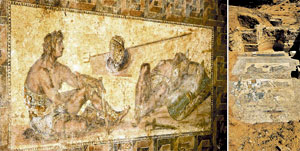








|
|
Times On Line
Roman mosaic "worthy of Botticelli"
By Dalya Alberge
june 13th, 2005
“I have examined hundreds of mosaics across the Roman Empire, but I have never seen such a vibrantly realistic depiction of a human.
“The image of the recumbent gladiator is nothing less than a Roman masterpiece executed by the Sandro Botticelli of his day. The human expression is captured in a realistic manner hitherto unknown in Roman mosaics.”
Archaeologists from the University of Hamburg were working along the coast of Libya when they uncovered a 30-ft stretch of five multicoloured mosaics created during the 1st or 2nd century. The mosaics show with extraordinary clarity four young men wrestling a wild bull to the ground, a warrior in combat with a deer and a gladiator. The gladiator is shown in a state of fatigue, staring at his slain opponent.
The mosaics decorated the cold plunge pool of a bath house within a Roman villa at Wadi Lebda in Leptis Magna, one of the greatest cities of antiquity.
Although the discovery was initially made in 2000, by Dr Marliese Wendowski of the University of Hamburg, it has been kept secret until now, partly to ensure that the excavations were not disturbed by looters.
It was also initially difficult for archaeologists to enter Libya. But since a settlement with the families of the Lockerbie victims and the lifting of international sanctions, the situation has changed.
Libya is now keen to open the country to tourists and these mosaics are being placed on public display at the Leptis Magna Mosaic Museum.
The full story of the discovery will be told in the July-August issue of Minerva, a London-based international review of ancient art and archaeology, which is published this week.
Dr Merrony, the deputy editor, whose doctorate from Oxford University was on ancient mosaics, said: “The image of the gladiator is executed in a manner that is so convincingly realistic that it appears to have been painted.
“Works of Renaissance art by Botticelli and others are well-known for deriving their inspiration from the human form in Classical art, but to find a Renaissance image on the floor of a Roman villa is unique.”

The mosaic discovered

|
|
|